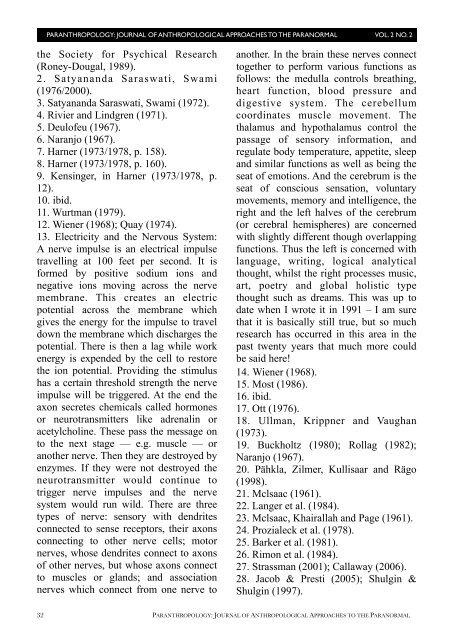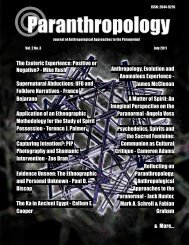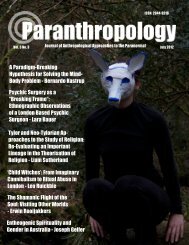Psi and Psychedelics - Paranthropology - Weebly
Psi and Psychedelics - Paranthropology - Weebly
Psi and Psychedelics - Paranthropology - Weebly
Create successful ePaper yourself
Turn your PDF publications into a flip-book with our unique Google optimized e-Paper software.
PARANTHROPOLOGY: JOURNAL OF ANTHROPOLOGICAL APPROACHES TO THE PARANORMAL VOL. 2 NO. 2<br />
the Society for Psychical Research<br />
(Roney-Dougal, 1989).<br />
2. Satyan<strong>and</strong>a Saraswati, Swami<br />
(1976/2000).<br />
3. Satyan<strong>and</strong>a Saraswati, Swami (1972).<br />
4. Rivier <strong>and</strong> Lindgren (1971).<br />
5. Deulofeu (1967).<br />
6. Naranjo (1967).<br />
7. Harner (1973/1978, p. 158).<br />
8. Harner (1973/1978, p. 160).<br />
9. Kensinger, in Harner (1973/1978, p.<br />
12).<br />
10. ibid.<br />
11. Wurtman (1979).<br />
12. Wiener (1968); Quay (1974).<br />
13. Electricity <strong>and</strong> the Nervous System:<br />
A nerve impulse is an electrical impulse<br />
travelling at 100 feet per second. It is<br />
formed by positive sodium ions <strong>and</strong><br />
negative ions moving across the nerve<br />
membrane. This creates an electric<br />
potential across the membrane which<br />
gives the energy for the impulse to travel<br />
down the membrane which discharges the<br />
potential. There is then a lag while work<br />
energy is expended by the cell to restore<br />
the ion potential. Providing the stimulus<br />
has a certain threshold strength the nerve<br />
impulse will be triggered. At the end the<br />
axon secretes chemicals called hormones<br />
or neurotransmitters like adrenalin or<br />
acetylcholine. These pass the message on<br />
to the next stage — e.g. muscle — or<br />
another nerve. Then they are destroyed by<br />
enzymes. If they were not destroyed the<br />
neurotransmitter would continue to<br />
trigger nerve impulses <strong>and</strong> the nerve<br />
system would run wild. There are three<br />
types of nerve: sensory with dendrites<br />
connected to sense receptors, their axons<br />
connecting to other nerve cells; motor<br />
nerves, whose dendrites connect to axons<br />
of other nerves, but whose axons connect<br />
to muscles or gl<strong>and</strong>s; <strong>and</strong> association<br />
nerves which connect from one nerve to<br />
another. In the brain these nerves connect<br />
together to perform various functions as<br />
follows: the medulla controls breathing,<br />
heart function, blood pressure <strong>and</strong><br />
digestive system. The cerebellum<br />
coordinates muscle movement. The<br />
thalamus <strong>and</strong> hypothalamus control the<br />
passage of sensory information, <strong>and</strong><br />
regulate body temperature, appetite, sleep<br />
<strong>and</strong> similar functions as well as being the<br />
seat of emotions. And the cerebrum is the<br />
seat of conscious sensation, voluntary<br />
movements, memory <strong>and</strong> intelligence, the<br />
right <strong>and</strong> the left halves of the cerebrum<br />
(or cerebral hemispheres) are concerned<br />
with slightly different though overlapping<br />
functions. Thus the left is concerned with<br />
language, writing, logical analytical<br />
thought, whilst the right processes music,<br />
art, poetry <strong>and</strong> global holistic type<br />
thought such as dreams. This was up to<br />
date when I wrote it in 1991 – I am sure<br />
that it is basically still true, but so much<br />
research has occurred in this area in the<br />
past twenty years that much more could<br />
be said here!<br />
14. Wiener (1968).<br />
15. Most (1986).<br />
16. ibid.<br />
17. Ott (1976).<br />
18. Ullman, Krippner <strong>and</strong> Vaughan<br />
(1973).<br />
19. Buckholtz (1980); Rollag (1982);<br />
Naranjo (1967).<br />
20. Pähkla, Zilmer, Kullisaar <strong>and</strong> Rägo<br />
(1998).<br />
21. Mclsaac (1961).<br />
22. Langer et al. (1984).<br />
23. Mclsaac, Khairallah <strong>and</strong> Page (1961).<br />
24. Prozialeck et al. (1978).<br />
25. Barker et al. (1981).<br />
26. Rimon et al. (1984).<br />
27. Strassman (2001); Callaway (2006).<br />
28. Jacob & Presti (2005); Shulgin &<br />
Shulgin (1997).<br />
32 PARANTHROPOLOGY: JOURNAL OF ANTHROPOLOGICAL APPROACHES TO THE PARANORMAL




